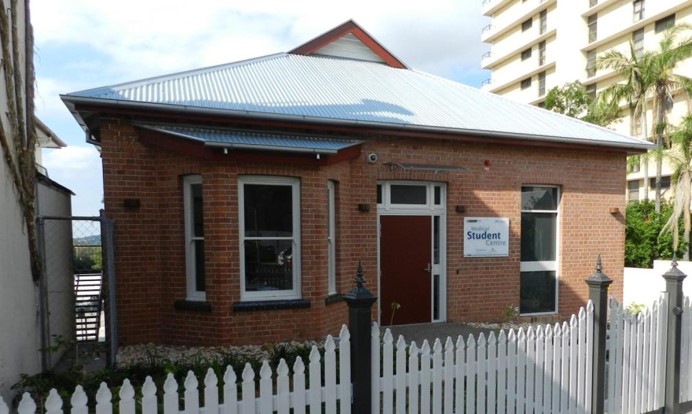Addresses
Type of place
House, Art gallery / studio
Period
Victorian 1860-1890
Style
Queen Anne
Addresses
Type of place
House, Art gallery / studio
Period
Victorian 1860-1890
Style
Queen Anne
Constructed circa 1875, this building is an important residential remnant of the type of land use at this locality during the mid to late 1800s. Built for John Walker, the building was maintained as a private residence until 1952 when it became a warehouse, and from 1965 to 2001 was the premises for Joy Bowman Galleries, which serviced Spring Hill’s arts community. It survives as a rare example of a mid to late nineteenth century brick residence in the Spring Hill area.
Also known as
Torquay
Lot plan
L1_RP10387
Key dates
Local Heritage Place Since —
Date of Citation —
Construction
Roof: Corrugated iron;Walls: Brick - Painted
People/associations
Joy Bowman Galleries (Association)Criterion for listing
(A) Historical; (B) Rarity; (G) SocialInteractive mapping
Also known as
Torquay
Lot plan
L1_RP10387
Key dates
Local Heritage Place Since —
Date of Citation —
Construction
Roof: Corrugated iron;Walls: Brick - Painted
People/associations
Joy Bowman Galleries (Association)Criterion for listing
(A) Historical; (B) Rarity; (G) SocialInteractive mapping
History
Evidence indicates that the date of construction of this dwelling is circa 1875 or possibly as early as 1866. The dwelling was constructed for John and Susanna Walker.
John Walker purchased just over 1 rood and 22 perches on 30 August 1864, two and a half years after he had been appointed a messenger for the Colonial Secretary’s Office. At this time Walker was about 36 years of age. An indication of the junior nature of his position in the public service is that his salary was ₤100/-/- pa in c1867.
A number of factors indicate the construction date of the dwelling. John Walker is listed as a resident of Leichhardt Street in the 1878-79 edition of the Queensland Post Office Directories. But in the previous, 1876 edition, a James Walker is listed as living at the same location. But in the 1874 edition, John Walker is listed only by his occupation as a public servant. Thus it is possible that Walker may have built his residence at 6 Leichhardt Street as early as 1866, which is when he took out his first mortgage on the land. The information included in each edition of the Queensland Post Office Directories was complied in the year prior to publication. So what is certain is that John (misprinted as James) Walker was receiving mail at his Leichhardt Street residence by 1875.
The style of the residence with its brick arches over the windows, also confirms the approximate construction date. The fact that Walker disposed of a portion the land may account for the slightly larger than normal masonry residence for a person of the social status of Walker.
While John Walker passed away on 9 February 1884, his wife remained in the house until her death on 16 March 1905. Her funeral procession left from the Leichhardt Street house. The property then had a number of owners. In the 1914 Brisbane City Council sewerage plan the residence is labelled “Torquay”. Alterations and additions were undertaken in June 1959.
Other applications were also submitted to the BCC regarding the use of the property. These include; Warehouse (1952), Medical (1959) and photography – Joy Bowman’s Galleries (1965). Though such applications and uses as these must be considered par for the course for a nineteenth century, inner city residence within Brisbane during the post World War Two period and latter half of the 20th Century.
Joy Bowman’s Galleries operated from 1965 to 2001, which was an extraordinary length of time for an arts-based business. Her business commenced at a time when Spring Hill was a run-down, inner suburb of Brisbane. The suburb provided low cost housing which attracted students and artists, the perfect customers for the Joy Bowman’s Galleries. Joy Bowman’s Galleries closed at a time when Spring Hill had been transformed into a desirable, rejuvenated suburb that attracted people drawn to modern inner city living.
Statement of significance
Relevant assessment criteria
This is a place of local heritage significance and meets one or more of the local heritage criteria under the Heritage planning scheme policy of the Brisbane City Plan 2014. It is significant because:
References
-
Brisbane City Council, Properties on the Web, website
-
Brisbane City Council, 1946 aerial photographs.
-
Brisbane City Council’s Central Library, local history sheets
-
Department of Natural Resources, Queensland Certificates of title and other records.
-
John Oxley Library, Parish of Nundah, County of Stanley, L.A.D. of Brisbane map, (1899 land grant map).
-
John Oxley Library, Brisbane Suburbs – Estate Maps
-
Queensland Government, Queensland Pioneers Index 1829-1889, (Brisbane: Department of Justice and Attorney General, 2000)
-
Queensland Post Office Directories, 1868-1949
Citation prepared by — Brisbane City Council (page revised June 2022)

